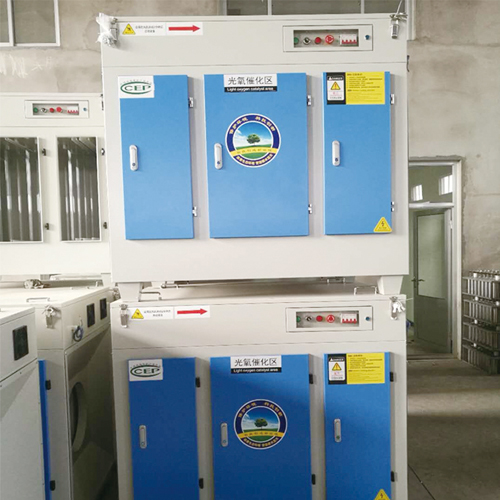Printing plant organic waste gas is the main source of printing ink and printing additives volatile organic waste gas, organic waste gas on people and the environment caused adverse effects, so can not be directly discharged, after the need for waste gas treatment equipment purification treatment can be discharged. The main components of organic waste gas in printing plant include benzene, aldehyde, alcohol and other organic waste gas. We developed a printing plant organic processing plan "wanchuan environmental protection UV photocatalytic oxidation purifier + activated carbon purification equipment", using this equipment can solve the problem of organic waste gas treatment for enterprises.
Printing plant organic waste gas treatment process:
The organic waste gas produced by the printing plant first enters the wanchuan environmental protection UV photocatalytic oxidation purifier under the action of negative pressure, then enters the activated carbon purification equipment, after the purification treatment, finally reaches the standard emissions.
Principle of organic waste gas treatment in printing plant:
UV photocatalytic oxidation purifier is the use of ultraviolet radiation in the air oxygen, oxygen into ozone, then ozone strong oxidation decomposition of waste gas molecules.
Activated carbon purification equipment is the use of activated carbon surface with developed pores, there is attraction between the pores, in the printing exhaust gas and activated carbon contact, the printing exhaust gas molecules will be adsorbed by activated carbon.

Without causing too much resistance to the flow of gas. Absorbent is the main medium for waste gas treatment. The properties and concentrations of the waste gas treatment equipment for printing presses are selected according to the properties of different waste gas, and the consumption per unit of gas is determined by calculating the ratio of absorbent to the molar flow rate of inert gas. ?? Photocatalysis can use sunlight as energy to activate the photocatalyst and drive the oxidation-reduction reaction, and the photocatalyst is not consumed in the reaction process. Absorption treatment of hydrogen sulfide waste gas it is an acid gas, hydrosulfuric acid formed in water, corrosive to metal. Hydrogen sulfide is oxidized by oxygen in the air to SO2 and water, and when oxygen is scarce or the temperature is low, sulfur and water are formed. The sulphide base is the raw material for the production of sulphide dye, which can be used in the production to prepare sodium polysulphide solution. Therefore, before absorption, a sulfur removal device is designed. A large amount of water vapor can easily cause the absorption liquid to become dilute, and increase the load of induced draft fan, which should also be removed. 30% sodium hydroxide solution into the absorption tower circulating tank, open the circulation pump nozzle spray mist, make tower fan will open shop waste gas absorption, the introduction of absorption system nearly boiling again teng state absorption of 24 hours sampling points, when the absorption liquid in the excess sodium hydroxide amount in more than 1%, compared to absorb the end point, change the absorption liquid, recovery of sodium sulfide solution. Dongtai high quality activated carbon adsorption tower device activated carbon adsorption box customized waste gas solution center? PP washing tower is that floating packing layer can improve on the warp and woof of industrial waste gas purifier, and a new kind of industrial waste gas treatment equipment, widely used in industrial waste gas treatment, dust removal, purification effect is very good, is now more commonly used in acid and alkali waste gas processing, a processing equipment is also useful.
Advantages of printing plant organic waste gas treatment equipment:
1. There is no secondary treatment of organic waste gas in the printing plant, and the purification efficiency is as high as 98%.
2. Easy to maintain, the parts to be cleaned are detachable modular combination, which not only facilitates the daily cleaning and maintenance of the equipment, but also facilitates the maintenance and replacement of these parts












